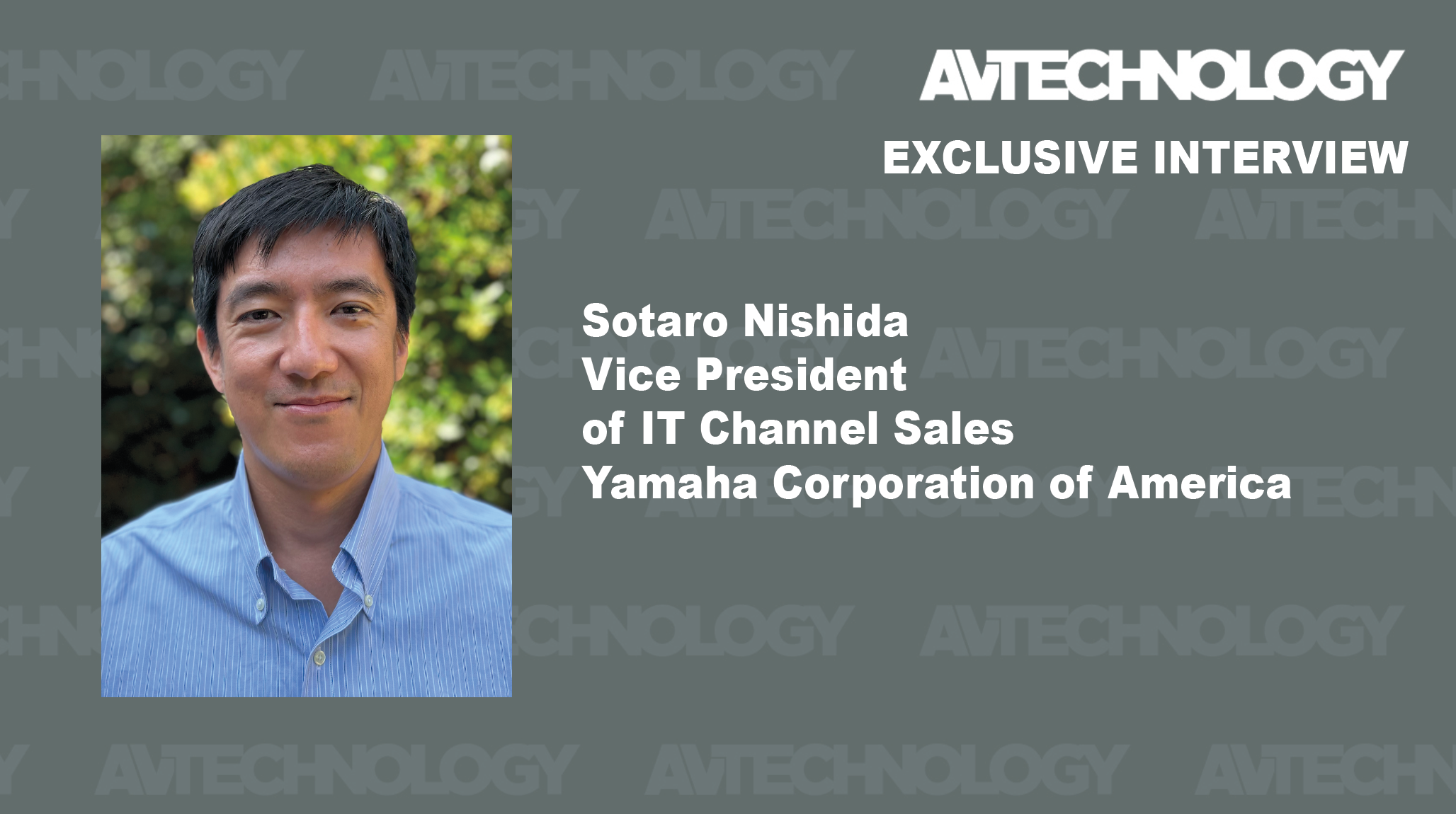The Official Word on Yamaha UC's Move to Yamaha Corporation of America
In an exclusive interview with AV Technology, learn what is in store for Yamaha's unified communications and conferencing offerings.

You're no doubt aware that the business of Yamaha Unified Communications (UC) is now done under the sister company, Yamaha Corporation of America—a shift finalized this past June due to changes in the market. On paper, the liquidation may seem like a major disruption to the status quo. In fact, the change positions the company's unified communications products and solutions for dramatic growth.
Sotaro Nishida, vice president of IT Channel Sales with Yamaha Corporation of America, recently sat down with AV Technology's content director, Cindy Davis to elaborate on the changes afoot. They discussed the status of the UC Pro AV business at Yamaha, where the company is headed regarding UC and Pro AV, and the future of the AV industry.
Setting the Record Straight
Now that the expert team from Yamaha UC has joined Yamaha Corporation of America, we have access to audio experts in different verticals and segments of the market."
—Sotaro Nishida
Nishida emphasized that working under the Yamaha Corporation of America name when it comes to Yamaha UC and conference solution product offerings, that absolutely nothing has changed. "We want to clarify that we are continuing this business in North America from a position of greater strength." He continued, "Now that the expert team from Yamaha UC has joined Yamaha Corporation of America, we have access to audio experts in different verticals and segments of the market. It's a very exciting time for us to be able to continue serving the same industry with expanded offerings."
Resellers and integrators are now able to seamlessly offer customers a complete solution for conferencing and UC installations. "There are a lot of projects requiring additional audio products or system components such as processors, amplifiers, and speakers to build on a larger scale. Now that we're part of Yamaha Corporation of America, the process is quicker, smoother, and more agile," Nishida said. "We are constantly fine-tuning our offerings and technical resources to be able to offer the services necessary for even the most complex projects."
"We Know How Sound Works"
Nishida credits Yamaha and its position of strength in the UC space as the result of generations of carefully honed and fortified audio technologies that have been applied to a diverse array of products and applications over the years.
"When it comes to eliminating noise or echoes with the signal processing—that comes from a long history," Nishida said. "We invented the digital mixer over 20 years ago, refining how audio is processed in the digital domain. We polished those products by coding the programs, recoding, testing, and trial and error. Because our technology is already so fortified there, we can apply it to our conference solutions very effectively. We can deliver an exceptionally high level of noise and echo cancellation, even if the product or hardware is in a different format. We can implant those programs into our systems in a well-applied way."
For Yamaha, its acoustic expertise and robust digital signal processing come together in its ADECIA conferencing system, which features auto-tuning. Nishida said, "Because every meeting space is different depending on the material of the wall, ceiling, floor, the size of the room, the distance sound needs to travel, as well as the dynamic range of many acoustic conditions, you'll want a conferencing system to auto-tune the room." He emphasized, "Yamaha has a long history, and we know how sound works."
A daily selection of features, industry news, and analysis for tech managers. Sign up below.
The Future is Simplified Audio
The teams at Yamaha are looking to leverage newly combined resources to continue growing its conferencing and UC offerings and innovating. Nishida explained that one of the main priorities at Yamaha is applying the existing auto-tuning capabilities of its microphones, speakers, and processors to the emergent area of advanced conference systems.
"When you have a large enough auditorium, classroom, or meeting space, traditionally, there will be a presenter with a handheld microphone or a wearable microphone. At some point, they'll need to check the battery level and frequency, and then the presenter needs to make sure he takes it off when leaving the room," Nishida said. "An advanced conference system is one where you don't have to worry about any of that. You just come into the room and start to speak at a normal, conversational level. The microphone will automatically pick you up, and you will be heard around the room because the microphones, speakers, processor, and amplifiers are already set up for the space while you can also stream your presentation online to remote participants through the same system."
Nishida continued, "We're getting to a point where our ideas of traditional audio systems are going to change. You don't have to think, 'This is the audio device. This is the microphone. These are the speakers. This is how I should speak. This is how I should sound.' It's going to be very intelligent. That is the future."
Parting Thoughts
Finally, when asked what Yamaha has in store that North American audiences may not be aware of, Nishida was quick to answer: "Network switches. We have a robust lineup of products already working in Pro AV applications. Our local area network switches come from our digital signal processing expertise and spin out of audio products." In addition to microphones, speakers, and processors, the ADECIA system is interconnected with a Dante POE switch. "We already have robust, super high-speed, accurate, and low-latency network switches, and we believe this will be the core of any AV system in the future. We want to strengthen that offering.
When you learn the history, audio, and IP communications have always been working together," Nishida concluded.

Cindy Davis is the brand and content director of AV Technology (AVT). She was a critical member of the AVT editorial team when the title won the “Best Media Brand” laurel in the 2018 SIIA Jesse H. Neal Awards. Davis moderates several monthly AV/IT roundtables and enjoys facilitating and engaging in deeper conversations about the complex topics shaping the ever-evolving AV/IT industry. She explores the ethos of collaboration, hybrid workplaces, experiential spaces, and artificial intelligence to share with readers. Previously, she developed the TechDecisions brand of content sites for EH Publishing, named one of the “10 Great Business Media Websites” by B2B Media Business magazine. For more than 25 years, Davis has developed and delivered multiplatform content for AV/IT B2B and consumer electronics B2C publications, associations, and companies. A lifelong New Englander, Davis makes time for coastal hikes with her husband, Gary, and their Vizsla rescue, Dixie, sailing on one of Gloucester’s great schooners and sampling local IPAs. Connect with her on LinkedIn.
